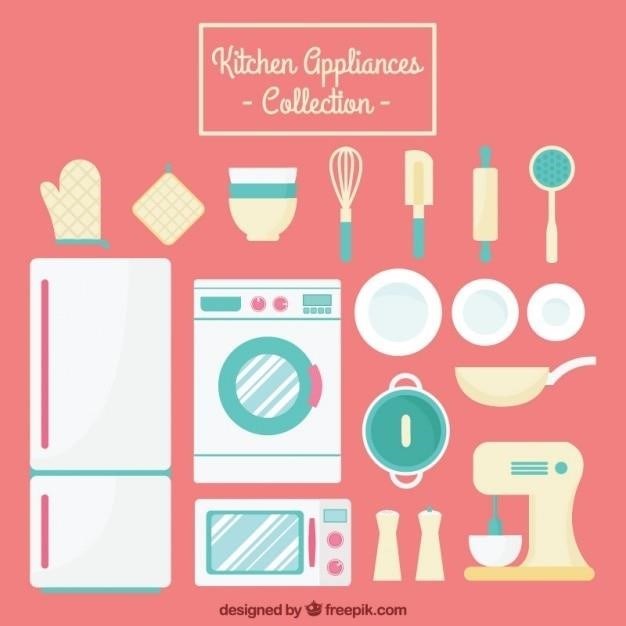
kitchenaid ice machine manual
KitchenAid Ice Maker Manual⁚ A Comprehensive Guide
This comprehensive guide provides detailed information about KitchenAid ice makers, covering everything from understanding the basic components to troubleshooting common issues․ It is an invaluable resource for owners of KitchenAid ice makers, offering a wealth of information to ensure optimal performance and longevity of their appliance․ The manual features step-by-step instructions, helpful tips, and detailed explanations to make navigating the world of KitchenAid ice makers easy and informative․
Introduction
Welcome to the world of KitchenAid ice makers, where convenience and refreshing ice cubes meet․ This manual is your comprehensive guide to understanding, operating, and maintaining your KitchenAid ice maker․ It is designed to provide you with all the information you need to maximize your ice-making experience and ensure that your appliance performs flawlessly for years to come․ From basic setup and operation to troubleshooting common issues and essential maintenance tips, this manual covers it all․ It serves as your one-stop resource, empowering you to confidently operate your KitchenAid ice maker and enjoy its benefits to the fullest․ Whether you’re a seasoned ice-making enthusiast or a first-time user, this manual will equip you with the knowledge you need to become an expert in the art of ice-making․

Understanding Your KitchenAid Ice Maker
Your KitchenAid ice maker is a marvel of modern appliance technology, designed to provide you with a continuous supply of fresh, delicious ice․ Understanding its key components and functions will help you operate it efficiently and troubleshoot any potential issues․ Your ice maker utilizes a sophisticated system of sensors, valves, and a compressor to create ice․ Water is drawn from your water supply, filtered, and then passed through a freezing chamber․ The compressor cools the chamber, causing the water to freeze into ice cubes․ Once the ice cubes are formed, they are harvested and dispensed into a bin or chute․ The entire process is controlled by a microprocessor that monitors the ice production, water levels, and temperature․ This ensures that your ice maker operates smoothly and produces high-quality ice․ Regular maintenance and cleaning are essential to keep your ice maker performing at its best․
Essential Components and Functions
The KitchenAid ice maker is a sophisticated appliance comprised of several essential components that work together to produce ice․ The water inlet valve controls the flow of water into the ice maker, while the water filter removes impurities from the water before it is frozen․ The ice tray, typically made of durable plastic, holds the water during the freezing process․ The compressor is the heart of the ice maker, responsible for cooling the freezing chamber and creating the ice․ A thermostat precisely controls the temperature of the freezing chamber, ensuring that the water freezes at the right rate․ Sensors monitor the ice level in the bin or chute, signaling when the ice maker needs to produce more ice․ The ice maker may also include a drain pump, which helps to remove any excess water or meltwater from the unit․ The ice maker’s control panel allows you to adjust settings, such as the size of the ice cubes and the amount of ice produced․ Understanding the function of each component helps you troubleshoot any issues that may arise with your ice maker․
Installation and Setup
Installing your KitchenAid ice maker is a straightforward process that involves a few key steps․ First, ensure you have a dedicated electrical outlet with adequate power capacity․ The ice maker should be positioned in a well-ventilated area away from direct sunlight and heat sources․ Connect the water supply line to the ice maker, making sure the shut-off valve is accessible for easy control․ This valve will allow you to shut off the water supply to the ice maker if needed․ Refer to the installation instructions provided with your specific model for detailed guidance on connecting the water line․ Once the water supply is connected, check for leaks and ensure the line is securely fastened․ Next, plug the ice maker into the electrical outlet and wait for a few hours for the unit to cool down before turning it on․ The ice maker should begin producing ice once it has reached the optimal temperature․ Refer to your user manual for specific instructions and any additional setup steps for your particular model․
Operating Your KitchenAid Ice Maker
Operating your KitchenAid ice maker is a simple process once you understand the basic controls․ Most models have a control panel with buttons for starting and stopping ice production, adjusting ice cube size, and accessing other settings․ The ice maker typically has an indicator light that illuminates when ice is being made․ The ice storage bin is usually transparent, allowing you to see how much ice is available․ To fill the ice bin, simply press the start button or switch the ice maker to the “on” position․ The ice maker will automatically produce ice cubes and fill the bin until it reaches the desired level․ You can adjust the ice cube size by selecting a smaller or larger cube setting on the control panel․ For some models, the ice maker might have a setting for “pause” or “hold” mode, allowing you to temporarily stop ice production while maintaining the optimal temperature for ice making․ Refer to the user manual for your specific model for detailed instructions on operating your KitchenAid ice maker and accessing its various settings․
Ice Maker Troubleshooting
While KitchenAid ice makers are generally reliable, occasionally issues may arise․ If your ice maker isn’t producing ice, or if the ice is not of the desired quality, there are several troubleshooting steps you can take․ First, ensure the ice maker is turned on and not paused․ Check if the water supply line is connected and the shut-off valve is open․ Make sure the ice maker’s arm is in the down position, allowing water to flow into the ice maker․ Refer to your owner’s manual for specific instructions related to your model․ If these basic checks don’t resolve the problem, inspect the water inlet valve for continuity․ If it has continuity but the water dispenser isn’t working, the issue could be with the refrigerator’s water inlet valve․ For recent installations, allow 24 hours for the refrigerator to cool down before expecting ice production․ In case of blocked drain tube, check the drain tube routing for restrictions and leaks․ Refer to the Use and Care Guide and Installation Instructions for detailed guidance․ For more complex issues, consult the troubleshooting section in your user manual or contact KitchenAid customer support․
Maintenance and Cleaning
Regular maintenance and cleaning are crucial for ensuring your KitchenAid ice maker’s optimal performance and longevity․ Always unplug the ice maker before cleaning to prevent electrical hazards․ Clean the exterior surfaces of the ice maker with warm water and mild dish soap, avoiding harsh abrasive cleaners that can damage the finish․ The ice maker’s interior should be cleaned regularly to prevent the accumulation of mineral deposits and bacteria․ This can be accomplished by removing the ice bin and washing it with warm water and mild dish soap․ Rinse thoroughly and dry both the bin and the interior of the ice maker before reassembling․ Pay special attention to the ice maker’s water inlet valve, as mineral deposits can restrict water flow․ To prevent clogging, clean the valve with a vinegar solution or a dedicated cleaning solution for ice makers․ Follow the instructions provided in your owner’s manual for cleaning the specific model of your KitchenAid ice maker․ Regular maintenance ensures the ice maker operates efficiently and produces clean, fresh ice․ If you encounter any difficulties during the cleaning process, consult your owner’s manual or contact KitchenAid customer support for guidance․
Warranty and Support
KitchenAid offers a comprehensive warranty on its ice makers, providing peace of mind and protection against defects․ The specific terms and conditions of the warranty can vary depending on the model and region of purchase․ Refer to the owner’s manual or the KitchenAid website for details on your specific warranty coverage․ If you encounter any issues with your ice maker during the warranty period, contact KitchenAid customer support for assistance․ They will guide you through the troubleshooting process and, if necessary, arrange for a repair or replacement․ Beyond the warranty period, KitchenAid provides ongoing support through its website and customer service channels․ You can find detailed user manuals, troubleshooting guides, and FAQs on the KitchenAid website․ If you need further assistance, contact KitchenAid customer support by phone, email, or online chat․ Their team of experts is available to answer your questions and provide guidance on operating, maintaining, and troubleshooting your KitchenAid ice maker․
A KitchenAid ice maker is an excellent investment for any household, providing a convenient and reliable source of ice for drinks, cocktails, and more․ With its user-friendly design, efficient operation, and robust construction, a KitchenAid ice maker can seamlessly integrate into your kitchen, enhancing your culinary experience․ By following the guidelines outlined in this manual, you can ensure that your KitchenAid ice maker operates at peak performance, providing years of reliable service․ Regular maintenance, proper cleaning, and prompt troubleshooting can extend the life of your appliance and prevent costly repairs․ Should you encounter any issues, consult the troubleshooting guide or contact KitchenAid customer support for assistance․ Remember, a well-maintained KitchenAid ice maker can provide a constant supply of fresh, quality ice, making it an indispensable addition to your kitchen arsenal․